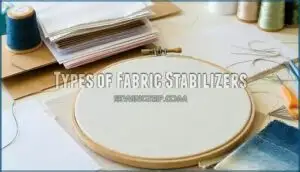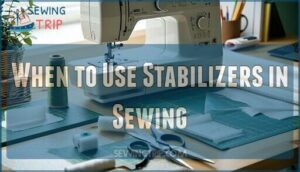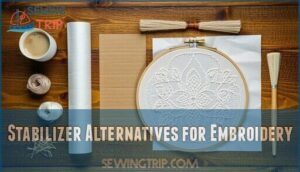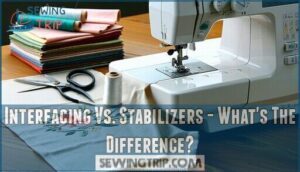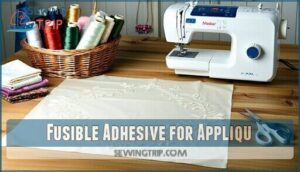This site is supported by our readers. We may earn a commission, at no cost to you, if you purchase through links.
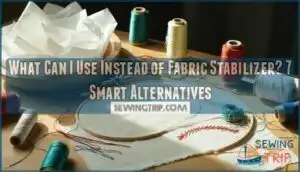
Coffee filters work wonders for small embroidery, while baking paper or freezer paper can steady your stitches without fuss. Wax paper’s slippery but does the trick for tracing patterns.
Even a scrap of cotton fabric can help if you’re in a pinch. Each substitute brings its own quirks—coffee filters are sturdy, freezer paper’s easy to peel, and cotton’s soft as a cloud.
So, don’t sweat it if your stabilizer runs out; your pantry’s got your back. Stick around for more clever hacks and pro tips to help you with your embroidery needs, and remember that these substitutes can be really helpful in a pinch.
Table Of Contents
- Key Takeaways
- Why Use Fabric Stabilizers?
- Types of Fabric Stabilizers
- When to Use Stabilizers in Sewing
- Stabilizer Alternatives for Embroidery
- Interfacing Vs. Stabilizers – What’s The Difference?
- Using Freezer Paper as a Stabilizer
- Fusible Adhesive for Appliqué
- Transferring Embroidery Patterns With Sulky Fabri-Solvy
- Frequently Asked Questions (FAQs)
- Conclusion
Key Takeaways
- You can grab coffee filters, baking paper, freezer paper, or cotton scraps from your kitchen when you’re out of fabric stabilizer.
- Test any homemade stabilizer substitute on a scrap first, since some alternatives can affect thread tension or leave marks.
- Starch and glue-based DIY stiffeners work but wash out quickly, so reapply if you need lasting support.
- Avoid thick materials like cardboard with your sewing machine, and stick to thin, flexible options to prevent needle jams.
Why Use Fabric Stabilizers?
Imagine this: you’re halfway through a gorgeous embroidery project when disaster strikes – puckered fabric that looks like it went through a washing machine mishap. That’s where fabric stabilizers swoop in as your sewing superhero!
Fabric stabilizers rescue your embroidery from puckering nightmares and keep your stitches looking flawless.
These unsung heroes provide essential fabric support during machine embroidery and decorative stitching. Without proper stabilization, your fabric becomes a wobbly mess that can’t handle dense thread work.
The result? Poor stitch quality that’ll make you want to toss your project in the trash. Think of stabilizers as your embroidery aid – they keep fabric taut and prevent it from shifting under the needle.
This fabric protection eliminates tunneling, where stitches sink into the material, and stops those annoying loops that scream "amateur hour." Different fabrics need different approaches.
Stretchy knits require cut-away stabilizers, while wovens work well with tear-away options. When you don’t have commercial stabilizers handy, fabric stabilizer alternatives like interfacing or coffee filters can save the day.
Understanding stabilizer types is vital for achieving professional-looking results.
The bottom line? Stabilizers guarantee sewing accuracy and professional-looking results every single time.
Types of Fabric Stabilizers
You’ll encounter four main types of fabric stabilizers, each designed for specific fabrics and stitching needs.
Understanding these options helps you choose the right support for your embroidery projects, whether you’re working with delicate silks or stretchy knits, to ensure the best results for your embroidery work.
Tear-Away
Tearaway stabilizers usually work best for stable fabrics like cotton and linen.
When you’re stuck without one, coffee filters make excellent fabric support for light embroidery projects.
They tear cleanly and won’t leave residue. For heavier work, try layered tissue paper or lightweight copy paper.
These stabilizer alternatives provide decent sewing stability during stitching. Remember, stabilizer removal should be gentle – tear slowly while supporting your embroidery to prevent distortion, and always handle with gentle care.
Cut-Away
Unlike tearaway stabilizers that you remove after stitching, cutaway stabilizer becomes your fabric’s permanent best friend.
This heavy duty support stays put, making it perfect for dense fabrics and stretchy materials like knits and jerseys.
You’ll trim the excess close to your embroidery, leaving a small border for ongoing fabric support.
When working with challenging stretch fabrics or high-density designs, cutaway stabilizer prevents puckering and distortion that would make tearaway stabilizers throw in the towel, ensuring durability matters most, and it’s your go-to choice for dense fabrics and stretchy materials.
Wash-Away
Water soluble stabilizers dissolve completely when you rinse your finished embroidery, making them perfect for delicate fabrics like lace or sheer materials.
You’ll find these washaway stabilizers incredibly handy for freestanding embroidery projects where you can’t leave any backing visible.
For fabric support without commercial washaway options, try rice paper or even thin tissue paper as stabilizer substitutes.
These embroidery stabilizer alternatives work great for gentle stiffening during stitching, then wash away cleanly.
Remember to store water soluble stabilizers in airtight containers since humidity can make them sticky before you’re ready for stabilizer removal.
Heat-Away
Heat-away stabilizers are your secret weapon when moisture’s the enemy.
They’re fantastic stabilizer substitutes when traditional heataway stabilizers aren’t available.
These thermal stabilizers melt away under a dry iron’s heat, making them perfect for synthetic fabrics or water-sensitive projects.
Unlike washaway stabilizers, heat dissolve options leave zero residue after iron-on removal.
Just remember—test your iron’s temperature first to avoid melting your masterpiece along with the stabilizer!
They’re a great option because they leave no residue, making them a secret weapon for delicate projects.
When to Use Stabilizers in Sewing
Smart sewers know when stabilizers become their secret weapon. Understanding timing prevents fabric disasters and saves precious projects from puckering nightmares.
Here’s when you’ll need stabilization support:
- High stitch density designs that pack thousands of stitches into small areas
- Lightweight fabric weight materials like silk, chiffon, or delicate cotton
- Fast sewing speed sessions where your machine races through intricate patterns
- Stretchy knits that love to distort under needle pressure
- Complex thread tension situations requiring extra fabric control
Machine settings play a huge role too. When you’re pushing your equipment’s limits with dense embroidery or appliqué work, fabric stabilizer alternatives become lifesavers.
Coffee filters, freezer paper, or interfacing can substitute when you’re out of commercial products. Don’t wing it with expensive fabrics though. Test your stabilizer substitute on scraps first—some alternatives affect thread tension differently than professional products.
Match your choice to your fabric’s personality, and you’ll avoid those "oops" moments that make you want to hide your sewing machine. Choosing the right stabilizer type is vital for achieving superior results in various sewing projects.
Stabilizer Alternatives for Embroidery
When you’re out of commercial stabilizer, don’t panic—your kitchen and office supplies can save the day.
Simple household items like coffee filters, baking paper, and even cardboard work surprisingly well to keep your embroidery looking crisp and professional.
Coffee Filters
Coffee filters aren’t just for your morning brew—they’re surprisingly handy as a fabric stabilizer substitute!
Grab a coffee filter from your kitchen drawer for instant, budget-friendly embroidery support—no fancy supplies needed!
These lightweight, cotton-polyester blend circles work perfectly as an embroidery aid for delicate projects.
Simply place one behind your fabric before hooping, and you’ll get decent stabilization without bulk.
The filter benefits include easy tear-away removal and budget-friendly convenience.
While they won’t handle heavy-duty designs, coffee filters excel at fabric stabilization for lightweight embroidery work.
Think of them as your homemade stabilizer when you’re in a pinch—just grab one from your kitchen drawer!
For projects requiring more durability, consider exploring coffee filter alternatives to find the best solution.
Baking Paper
The humble baking paper (parchment paper) becomes a surprisingly effective fabric stabilizer substitute when you’re in a pinch. This kitchen staple’s non-stick surface prevents fabric from distorting under your needle, making it perfect for lightweight embroidery projects.
Here’s how to master this clever sewing aid:
- Cut baking paper slightly larger than your hoop for complete embroidery backing coverage
- Position the shiny side against your fabric to prevent thread snags
- Use gentle needle pressure to avoid tearing this temporary stabilizer
- Remove carefully after stitching to maintain clean design edges
- Save scraps for smaller projects or pattern testing
Test this homemade stabilizer on fabric scraps first, ensuring your machine handles it smoothly before tackling important projects. For best results, consider using a baking paper substitute to achieve superior embroidery outcomes. This will help you to create beautiful embroidery with ease and precision, making it a great sewing aid.
Wax Paper
While baking paper offers smooth surfaces, wax paper brings its own charm to your stitching adventures.
This slippery customer works as an emergency stabilizer when you’re caught without proper supplies.
Wax paper uses include backing lightweight fabrics during simple embroidery, though it’s definitely more fragile than commercial options.
As a budget stabilizer, it costs pennies and prevents fabric shifting during low stitch count designs.
The waxy coating creates a barrier between needle and thread, reducing snags.
However, this lightweight backing tears easily, so handle with care.
Paper substitutes like wax paper work best on cotton or linen with basic patterns.
Pro tip: combine wax paper with starch spray for extra hold on tricky fabrics.
While it won’t replace professional stabilizers for complex work, it’s perfect for quick fixes when tissue paper stabilizer isn’t available.
For more complex projects, considering no-sew fabric solutions like fusible web alternatives can provide additional support and stability.
Fabric Substitute
Beyond wax paper, you’ll find plenty of fabric alternatives that won’t break the bank.
These DIY stabilizer options work surprisingly well when you’re in a pinch.
- Cardboard stabilizer – Clean, sturdy cardboard cut to size provides excellent support for heavy embroidery projects
- Paper products – Coffee filters and tissue paper offer lightweight backing for delicate fabrics
- Fabric alternatives – Muslin or cotton scraps create reusable, washable stabilizers that match your project’s weight
- Natural stiffeners – Homemade starch solutions give you eco-friendly control over fabric stiffness levels
Interfacing Vs. Stabilizers – What’s The Difference?
Many sewers mix up interfacing and stabilizers, but they’re completely different Sewing Aids with unique jobs. Think of interfacing as your fabric’s permanent bodyguard – it stays put in collars, cuffs, and waistbands to maintain shape.
Stabilizers, however, are temporary helpers that prevent embroidery disasters and then disappear.
Here’s the breakdown:
| Aspect | Interfacing | Stabilizers |
|---|---|---|
| Purpose | Adds permanent structure | Prevents stitching distortion |
| Removal | Stays in garment | Removed after sewing |
| Best For | Garment construction | Embroidery Backing projects |
Interfacing Uses focus on garment structure, while Stabilizer Types target embroidery precision. You wouldn’t use a fabric stabilizer substitute in a shirt collar, just like you wouldn’t use interfacing as an embroidery stabilizer substitute.
Each provides specific Fabric Support – interfacing for shape retention, stabilizers for stitch quality. Understanding this difference saves you from wonky projects and helps you choose the right tool for professional results.
Using Freezer Paper as a Stabilizer
Switching gears from interfacing, let’s chat about freezer paper stabilizer. This Crafting Hack is a game changer for quick projects! Just iron the shiny side to fabric, and voilà—Temporary Backing for tracing, drawing, or stitching.
When you’re done, peel it off with zero fuss. Want more Freezer Paper Tips? Try these:
- Reusable for multiple designs
- Easy Adhesive Removal, no sticky mess
- Adjust Paper Thickness for extra stability
It’s a freezer paper stabilizer substitute that’s budget-friendly! The use of freezer paper involves understanding paper stabilizer options to achieve the best results, making it a great option for quick projects.
Fusible Adhesive for Appliqué
Your grandma’s quilt secrets might just involve fusible adhesive—seriously, it’s a game changer for appliqué.
Instead of fussing with pins or fabric stabilizer, you can use fusible interfacing and a heat press to bond your designs in a flash.
Just trace your pattern onto fusible web sheets, iron it to the back of your fabric, cut out the shapes, peel, and press onto your project.
It’s so easy, you’ll wonder why you ever wrestled with sticky fingers or runaway appliqué pieces.
For quick fixes, fabric glue sticks or basting spray work wonders too.
If you ever need to unstick, steam helps lift it off gently.
Understanding fabric weight options is essential for achieving the desired texture and stability in your appliqué projects.
Here’s a handy table for comparing Adhesive Types and Sticking Methods:
| Adhesive Types | Fabric Bonding | Heat Press | Appliqué Tips |
|---|---|---|---|
| Fusible Adhesive | Permanent | Yes | Fast, neat |
| Glue Stick | Temporary | No | Easy to move |
| Basting Spray | Temporary | No | Quick setup |
| Fusible Interfacing | Permanent | Yes | Sturdy finish |
Transferring Embroidery Patterns With Sulky Fabri-Solvy
If you’re tired of tracing patterns by hand or fighting with slippery fabric, Sulky FabriSolvy is your embroidery aid in shining armor.
For spot-on pattern transfer, just print or trace your design onto the matte side, cut it out, and stick it to your fabric—no wrestling with carbon paper.
It’s perfect for tricky fabrics, like knits or dark colors, and keeps everything in place while you stitch, making it a stabilizer substitute that actually works.
When you’re done, soak your masterpiece and watch the stabilizer vanish, and to achieve professional results, understanding transfer methods is essential for any embroidery project, ensuring your embroidery patterns look sharp every time with the help of these Sulky tips.
Frequently Asked Questions (FAQs)
What is an alternative to fabric stabilizer?
Think outside the box—literally!
You can use clean cardboard, coffee filters, or even baking paper as quick fabric stabilizer substitutes.
They’re cheap, easy to find, and perfect when your sewing stash runs dry, making them a great alternative.
What can I use to stabilize fabric?
You can stabilize fabric with coffee filters, baking paper, or even a clean cardboard cut to size.
Felt works too.
If you’re feeling crafty, mix cornstarch and water for a homemade stiffener—easy, cheap, and washable!
How do homemade stabilizers affect fabric longevity?
Mix, dip, and dry—homemade stabilizers like starch or glue stiffen fabric but wash out fast, so you’ll need to reapply.
If you want long-lasting results, commercial stabilizers usually outshine DIY tricks in staying power.
Can natural stiffeners cause fabric discoloration?
Yep, natural stiffeners like starch or gelatin can sometimes leave your fabric looking a bit yellow or spotty, especially if you go heavy-handed.
Always test on a scrap first—nobody wants surprise polka dots on their masterpiece!
Is starch safe for delicate embroidery fabrics?
Starch is usually safe for delicate embroidery fabrics, but test it first on a scrap.
Too much starch can stiffen things up like a board, and sometimes it leaves a faint mark—so don’t skip the patch test!
Will DIY stabilizers work with sewing machines?
You can totally use DIY stabilizers with your sewing machine, just keep things thin—coffee filters, baking paper, or even freezer paper work well.
Avoid thick cardboard or plastic, or your needle might throw a tantrum!
How to remove glue-based stiffeners from fabric?
Like peeling stickers off a lunchbox, soak your fabric in warm, soapy water, then gently rub the glue spots with your fingers.
If it’s stubborn, try a soft brush—just don’t scrub like you’re cleaning grout!
Conclusion
Did you know about 70% of home embroiderers run out of fabric stabilizer at least once?
So, if you’re wondering what can I use instead of fabric stabilizer, your kitchen’s got your back.
Coffee filters, baking paper, and even old cotton shirts can save your project in a pinch. Next time you’re stuck, don’t panic—just get creative.
With these clever hacks, you’ll keep your stitches neat and your sanity intact. Who knew embroidery could be this resourceful?
- https://maggieframestore.com/ja/blogs/maggieframe-news/sticky-fabri-solvy-ultimate-guide-for-effortless-embroidery-on-any-fabric
- https://peacockandfig.com/2018/01/top-three-transferring-embroidery-patterns/
- https://www.reddit.com/r/Embroidery/comments/18xhepp/what_can_be_an_alternative_to_sulky_fabric_solvy/

